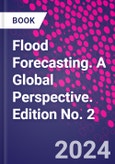Flood Forecasting: A Global Perspective, Second Edition covers hydrologic forecasting systems on both a national and regional scale. This updated edition includes a breakdown by county contribution and solutions to common issues with a wide range of approaches to address the difficulties inherent in the development, implementation and operational success of national-scale flood forecasting systems. Special attention is given to recent advances in machine learning techniques for flood forecasting. Overall, the information will lead to improvements of existing systems and provide a valuable reference on the intricacies of forecast systems in different parts of the world.
Please Note: This is an On Demand product, delivery may take up to 11 working days after payment has been received.
Table of Contents
1. National and Regional Flood Forecasting Systems
2. Continental Modeling and Monitoring -- the future?
3. Challenges facing flood forecasting
Authors
Thomas E. Adams Senior Hydrometeorological Hazard Advisor, USAID, Bureau for Humanitarian Assistance, Lebanon, OH, USA. Dr Thomas Adamas has 35+ years of experience in hydrology, including twenty years of real-time operational hydrologic forecasting experience at the NOAA/National Weather Service (NWS), Ohio River Forecast Center (OHRFC), including model parameter estimation, hydrologic and hydraulic modeling, and model calibration.?Previously Dr. Adams was a Research Hydrologist at the NOAA/NWS Office of Hydrology/Hydrology Laboratory and a Visiting Scientist with the University Corporation for Atmospheric Research (UCAR) at the NOAA/NWS National Water Center. His experience includes the development and implementation of the Ohio River Community HEC-RAS Model, operational probabilistic/ensemble hydrologic forecasting, precipitation estimation and analysis, land surface/atmosphere interaction, and impact of global climate change on water resources.?
He is involved in on-going international hydrometeorological consulting and is a member of the American Geophysical Union, American Meteorological Society, American Society of Civil Engineers, and the Soil Science Society of America. Chandana Gangodagamage Research Scientist, NASA Goddard, Greenbelt, Maryland, USA. Dr Chandana Gangodagamage has 13 years of experience in hydrology, including Experiments in spatial data modeling, simulation, and extraction of multi-scaling structure in river basin data using high resolution; research using NASA SWOT mission, developed a methodology to extract: (1) a global scale high resolution DEM for hydrodynamic modeling, and; (2) vegetation height structure to understand carbon sequestration from Shuttle Radar Topography Mission; worked with Terrestrial Hydrology, Earth Surface Processes, and Arctic Hydrology research teams to develop LANL predictive capabilities in hydrology and water resources using space- based technologies.
Currently with NASA Goddard he leads the development of LISHydro framework for the NASA GSFC. He implemented a surface water routing scheme in the NASA Land Information System (LIS). Specific responsibilities will include 1) the design and implementation of surface routing schemes in LIS, 2) the coupling of LIS with the National Water Model (WRF-Hydro) and other routing schemes, 3) the support of data preprocessing required by the channel routing algorithms, 4) conduct research on the impact of land surface modeling and data assimilation on surface water formulations, (5) coupling the LISHydro with different land surface models including NoanMP.3.6, NoahMP.4.0.1, VIC etc., (5) Develop support for different meteorological forcing schemes including MERR2
Previously Dr. Gangodagamage was a Postdoctoral Researcher at Byrd Polar Research Center, Ohio State University and at Los Alamos National Laboratory, Los Alamos, USA. He was also an Assistant Surface Water Hydrologist, Argonne National Laboratory Environmental Science Division (EVS), Argonne National Laboratory, Argonne, IL; a Visiting Scientist: The Center for Spatial Technologies and Remote Sensing, Department of Land, Air and Water Resources, University of California, Davis, and a Visiting Scientist with the University Corporation for Atmospheric Research (UCAR) at the NOAA/NWS National Water Center
Current memberships include:
. Member, American Geophysical Union, 2004 - present.
. Member, American Meteorological Society, 2006 -present.
. Member, Geoinformatics society of Sri Lanka, Member, Institute of Engineers, Sri Lanka.
. Member, Institute of Electrical and Electronic Engineers (IEEE)
. Member, IEEE Geosciences and Remote Sensing Society (IEEE)
. Associate Member, American Society of Civil Engineers Thomas C. Pagano Australian Bureau of Meteorology, Melbourne, Australia. The unifying theme of Dr. Thomas Pagano's career has been using operational river forecasts to bring the benefits of science to the public. He studied Hydrology and Water Resources at the University of Arizona, Tucson, USA and obtained his doctorate under the supervision of Professor Soroosh Sorooshian in 2004. He then worked as an operational river forecaster with the USDA Natural Resources Conservation Service National Water and Climate Center in Portland, Oregon, forecasting the Colorado River, Rio Grande, Arkansas River and for Alaska. In 2008 he joined the Australian Commonwealth Scientific and Industrial Research Organisation to lead a research program in flood forecasting. He has been the leader of the national flood modelling group within the Hazards Warnings and Forecasts division of the Australian Bureau of Meteorology since 2013.








